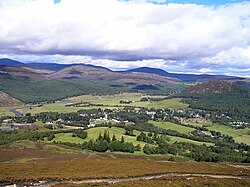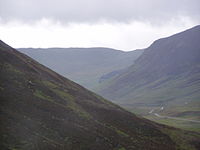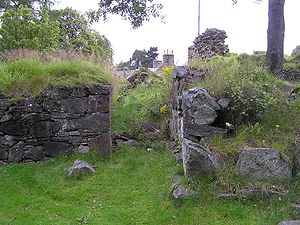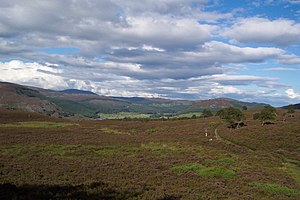Braemar: Difference between revisions
Created page with '{{infobox town |name=Braemar |county=Aberdeenshire |picture=Braemar from morrone 01SEP06.jpg |picture caption=Braemar from the hills |population=839 |census year=2001 |os_grid_re…' |
|||
| Line 77: | Line 77: | ||
===Morrone Birkwood Nature Reserve=== | ===Morrone Birkwood Nature Reserve=== | ||
[[File:Morrone Birkwood Nature Reserve.jpg|thumb|right|Morrone Birkwood Nature Reserve]] | [[File:Morrone Birkwood Nature Reserve.jpg|thumb|right|Morrone Birkwood Nature Reserve]] | ||
The '''Morrone Birkwood Nature Reserve''' is a | The '''Morrone Birkwood Nature Reserve''' is a nature reserve on the edge of the village reached from the car park at the top of Chapel Brae. | ||
==Picture gallery== | ==Picture gallery== | ||
Latest revision as of 12:04, 5 January 2016
| Braemar | |
| Aberdeenshire | |
|---|---|
 Braemar from the hills | |
| Location | |
| Location: | 57°-0’36"N, 3°24’-0"W |
| Data | |
| Population: | 839 (2001) |
| Post town: | Ballater |
| Postcode: | AB35 |
| Dialling code: | 013397 |
| Local Government | |
| Council: | Aberdeenshire |
Braemar is a village in Aberdeenshire, high in the mountains some 58 miles west of Aberdeen. It is the closest sizable village to the upper course of the River Dee sitting at an altitude of 1,110 feet.
The village is built around the great castle of Kindrochit at its heart and though the castle lies in ruins the village thrives. Kindrochit was in its time a great centre, a playground of kings, nobles and the great ones of the land for a millennium, drawing its strength from its strategic position. The castle commanded the glens leading in and out of the area; Glenshee to the south, Aberdeen eastward, Lairig Ghru and Lairig an Laoigh to the north and Glen Tilt and Glen Feshie to the west.
The name of Braemar is from Gaelic (which is no longer spoken in the parish), in which its name is Braigh Mharr, meaning "the hills of Marr", Marr being the lands west of Aboyne.
Royal Deeside
Queen Victoria came to Deeside and was enchanted. In 1848 Prince Albert acquired the lease of the Balmoral Estate and in 1852 bought the estate outright, and at once began the building of a new royal residence to replace the old Balmoral castle. Ever since, Balmoral has served as a Highland home for the sovereign.
The Royal Family have been joined by many other holiday-makers who come to the area for the mountains and the open space and the fishing. Modern Braemar is a centre for mountain walking.
Braemar is the highest and most mountainous parish in Britain; across 182,000 acres nowhere is lower than 1000 feet above sea level. The village centre is at 1110 feet.
Highest and coldest

The immediate area contains some 24 Munros, mountains of over 3,000 feet, with three over 4,000 feet. The parish is at the edge of Aberdeenshire and borders four other Counties (Banffshire, Inverness-shire, Perthshire and Angus).
Braemar’s golf course is the highest 18-hole course in the country
The Cairnwell Pass between Aberdeenshire and Perthshire is, at 2,100 feet, the highest through road in the country. On the Braemar side it passes through the Glenshee Ski Centre.
Braemar is also the coldest village in the British Isles, with a mean temperature of 6.5 ºC. It has twice entered the UK Weather Records with the lowest ever temperature of -27.2° on 11 February 1895 and 10 January 1982.[1]
Leisure
Walking, wildlife and fishing are the themes of Braemar and its area. The hills around the village are rich in red deer, roe deer, pheasants, red squirrels and hares, hunted by eagles and buzzards. In season the hills are trodden by deerstalkers.
Mountain climbing is popular, and less strenuous mountain activities.
Anglers come for trout and salmon in which the rivers abound.
History
The village is at the upper end of the historical Earldom of Mar, from which it takes its name.[2]
The use of Braemar to refer specifically to the village rather than the area of the Braes O’Mar dates to around 1870, before which two independent hamlets existed on the banks of the Clunie Water; Auchendryne on the western bank, and Castleton on the eastern bank, the latter referring to Kindrochit Castle in the village rather than Braemar Castle[2] (immediately south of the village). The names Auchendryne and Castleton are still marked on the current Ordnance Survey maps as part of the village.

Traditionally, Malcolm III with his first Queen came to the area in around 1059, and according to legend held a great gathering at the original village of Doldencha, situated under the present-day graveyard. He is also credited with having built a timber bridge across the Clunie and the original Kindrochit Castle, the siting of which was derived from a strategic relation to the crossings of the Grampian Mounth.[3] The ruins of Kindrochit Castle on the east bank of the Clunie Water, slightly upriver from the bridge in Braemar, are considered to be largely of 14th century origin replacing the presumed timber-construction of the original castle. The name Kindrochit means (bridge end)[2] while the castle is the source of the name Castleton.
On 6 September 1715 the Earl of Mar raised the Jacobite standard at Braemar, instigating the 1715 rising against the Hanoverian Succession.
Into the 20th century the village was almost completely owned and divided by the adjoining estates of Mar: Auchendryne and Invercauld on the one side; and Castleton on the other. To some extent the rivalry between the estates led to the building of the Fife Arms Hotel in Auchendryne, and the Invercauld Arms Hotel in Castleton. Interestingly, the Invercauld Arms was built over the mound where John "Bobbing John" Erskine, 6th Earl of Mar raised the Jacobite standard in 1715.[2]
Auchindryne belonged to a branch of the Farquharsons until it was forfeited in the aftermath of the Jacobite rising of 1745. Later that century it was acquired by William Duff, 1st Earl Fife.
Braemar Gathering
The Braemar Gathering is known colloquially as The Games and originated in those believed to have been held by Malcolm III. The Gathering is an annual Highland Games Gathering held at Braemar on the first Saturday in September and is traditionally attended by the Royal Family.
In 1746 the Act of Proscription stopped all clan gatherings, but following its repeal in 1782 the old enthusiasms for such events returned.[2] About 1826 the Braemar Highland Society was created; the first modern-day games taking place in 1832. On the 14th September 1844 Queen Victoria attended the gathering at Invercauld. In 1866 Royal was added to Braemar Highland Society and in 1906 the Duke of Fife presented 12 acres of the Mar Estate to the Society and The Princess Royal and Duke of Fife Memorial Park, the current home of the Braemar Gathering, was created.
Since Queen Victoria's time the reigning Monarch has been the patron of the Braemar Royal Highland Society.
Picture gallery of the 2006 Gathering
This gallery shows general views of the 2006 Braemar Gathering
Morrone Birkwood Nature Reserve

The Morrone Birkwood Nature Reserve is a nature reserve on the edge of the village reached from the car park at the top of Chapel Brae.
Picture gallery
Pictures in and around Braemar:
-
Braemar from Morrone
-
Auchendryne Lodge (September 2006)
-
Sunset as seen at a field in Braemar
-
The Gordon's Tearoom and Bakery
-
The Braemar Gallery, and Police Station
Notes and references
- ↑ United Kingdom Meteorological Office statistics
- ↑ 2.0 2.1 2.2 2.3 2.4 Fenton Wyness (1968). Royal Valley : The Story Of The Aberdeenshire Dee. Aberdeen: Alex P. Reid & Son.
- ↑ C. Michael Hogan, Elsick Mounth, Megalithic Portal, editor: Andy Burnham (2007)








